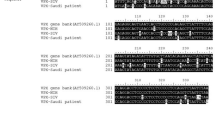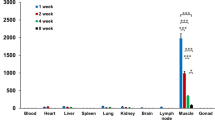Abstract
The viral accessory protein Vpx is required for productive in vitro infection of macrophages by simian immunodeficiency virus from sooty mangabey monkeys (SIV SM ). To evaluate the roles of Vpx and macrophage infection in vivo , we inoculated pigtailed macaques intravenously or intrarectally with the molecularly cloned, macrophage tropic, acutely pathogenic virus SIV SM PBj 6.6, or accessory gene deletion mutants (ΔVpr or ΔVpx) of this virus. Both wild-type and SIV SM PBj ΔVpx viruses were readily transmitted across the rectal mucosa. A subsequent 'stepwise' process of local amplification of infection and dissemination was observed for wild-type virus, but not for SIV SM PBj ΔVpx, which also showed considerable impairment of the overall kinetics and extent of its replication. In animals co-inoculated with equivalent amounts of wild-type and SIV SM Pbj ΔVpx intravenously or intrarectally, the ΔVpx mutant was at a strong competitive disadvantage. Vpx-dependent viral amplification at local sites of initial infection, perhaps through a macrophage-dependent mechanism, may be a prerequisite for efficient dissemination of infection and pathogenic consequences after exposure through either mucosal or intravenous routes.
This is a preview of subscription content, access via your institution
Access options
Subscribe to this journal
Receive 12 print issues and online access
$209.00 per year
only $17.42 per issue
Buy this article
- Purchase on Springer Link
- Instant access to full article PDF
Prices may be subject to local taxes which are calculated during checkout





Similar content being viewed by others
References
Wolfs, T.F.W., Zwart, G., Bakker, M. & Goudsmit, J. HIV-1 genomic RNA diversification following sexual and parenteral virus transmission. Virology 189, 103–110 ( 1992).
Keet, I.P.M. et al. Predictors of rapid progression to AIDS in HIV-1 seroconverters. AIDS 7, 51–57 (1993).
Zhu, T. et al. Genotypic and phenotypic characterization of HIV-1 in patients with primary infection. Science 261, 1179– 1181 (1993).
Roos, M.T.L. et al. Viral phenotype and immune response in primary human immunodeficiency virus type 1 infection. J. Infect. Dis. 165, 427–432 (1992).
Nielsen, C., Pedersen, C., Lundgren, J.D. & Gerstoft, J. Biological properties of HIV isolates in primary HIV infection: consequences for the subsequent course of infection. AIDS 7, 1035–1040 (1993).
Lu, L. et al. Vaginal transmission of chimeric simian/human immunodeficiency viruses in rhesus macaques. J. Virol. 70, 3045– 3050 (1996).
Berger, E.A. et al. A new classification for HIV-1. Nature 391, 240 (1998).
Heinzinger, N. et al. The Vpr protein of human immunodeficiency virus type 1 influences nuclear localization of viral nucleic acids in nondividing host cells. Proc. Natl. Acad. Sci. USA 91, 7311– 7315 (1994).
Bailliet, J.W. et al. Distinct effects in primary macrophages and lymphocytes of the human immunodeficiency virus type I accessory genes vpr, vpu and nef: mutational analysis of a primary HIV-1 isolate. Virology 200, 623–631 (1994).
Connor, R.I., Chen, B.K., Choe, S. & Landau, N.R. Vpr is required for efficient replication of human immunodeficiency virus type-1 in mono-nuclear phagocytes. Virology 206, 935– 944 (1995).
Campbell, B.J. & Hirsch, V.M. Vpr of simian immunodeficiency virus of African green monkeys is required for replication in macaque macrophages and lymphocytes. J. Virol. 71, 5593–5602 (1997).
Fletcher, T.M. et al. Nuclear import and cell cycle arrest functions of the HIV-1 Vpr protein are encoded by two separate genes in HIV-2/SIMSM. EMBO J. 15, 6155–6165 (1996).
Vodicka, M.A., Koepp, D.M., Silver, P.A. & Emerman, M. HIV-1 Vpr interacts with the nuclear transport pathway to promote macrophage infection. Genes Dev. 12, 175– 185 (1998).
He, J. et al. Human immunodeficiency virus type 1 viral protein R (Vpr) arrests cells in the G2 phase of the cell cycle by inhibiting p34cdc2 activity. J. Virol. 69, 6705–6711 (1995).
Jowett, J.B.M. et al. The human immunodeficiency virus type 1 vpr gene arrests infected T cells in the G2 + phase of the cell cycle. J. Virol. 69, 6304–6313 (1995).
Re, F., Braaten, D., Franke, E.K. & Luban, J. Human immunodefciency virus type 1 Vpr arrests the cell cycle in G2 by inhibiting the activation of p34cdc2-cyclin B. J. Virol. 69, 6859–6864 (1995).
Rogel, M.E., Wu, L.I. & Emerman, M. The human immunodeficiency virus type 1 vpr gene prevents cell proliferation during chronic infection. J. Virol. 69, 882–888 (1995).
Stivahtis, G.L., Soares, M.A., Vodicka, M.A., Hahn, B.H. & Emerman, M. Conservation and host specificity of Vpr-mediated cell cycle arrest suggest a fundamental role in primate lentivirus evolution and biology. J. Virol. 71, 4331–4338 (1997).
Sharp, P.M., Bailes, E., Stevenson, M., Emerman, M. & Hahn, B.H. Gene acquisition in HIV and SIV. Nature 383, 586–587 (1996).
Fultz, P.N. & Zack, P.M. Unique lentivirus-host interactions: SIVSMMPBj14 infection of macaques. Virus Research 32, 205–225 (1994).
Lifson, J.D. et al. The extent of early viral replication is a critical determinant of the natural history of simian immunodeficiency virus infection. J. Virol. 71, 9508–9514 (1997).
Watson, A. et al. Plasma viremia in macaques infected with simian immunodeficiency virus: plasma viral load early in infection predicts survival. J. Virol. 71, 284–290 (1997).
Wolinsky, S.M. et al. Selective transmission of human immunodeficiency virus type 1 variants from mothers to infants. Science 255, 1134–1137 (1992).
Zhang, L. et al. Rate of SIV particle clearance in rhesus macaques in 5th Conference on Retroviruses and Opportunistic Infections (Chicago, Illinois 1998).
Sleigh, R., Sharkey, M., Newman, M.A., Hahn, B. & Stevenson, M. Differential association of uracil DNA glycosylase with SIVSM Vpr and Vpx proteins. Virology 245(1998).
Selig, L. et al. Uracil DNA glycosylase specifically interacts with Vpr of both human immunodeficiency virus type 1 and simian immunodeficiency virus of sooty mangabeys, but binding does not correlate with cell cycle arrest. J. Virol. 71, 4842–4846 (1997).
Spira, A.I. et al. Cellular targets of infection and route of viral dissemination after an intravaginal inoculation of simian immunodeficiency virus into rhesus macaques. J. Exp. Med. 183, 215– 225 (1996).
Reece, J.C. et al. HIV-1 selection by epidermal dendritic cells during transmission across human skin. J. Exp. Med. 187, 1623–1631 (1998).
Miller, C.J. Mucosal transmission of simian immunodeficiency virus. Curr. Top. Microbiol. Immunol. 188, 107 (1994).
Desrosiers, R.C. et al. Macrophage-tropic variants of SIV are associated with specific AIDS-related lesions but are not essential for the development of AIDS. Am. J. Pathol. 139, 29–35 (1991).
Zaitseva, M. et al. Expression and function of CCR5 and CXCR4 on human Langerhans cells and macrophages: implications for HIV primary infection. Nature Med. 3, 1369–1375 (1997).
Gibbs, J.S. et al. Progression to AIDS in the absence of a gene for vpr and vpx. J. Virol. 69, 2378– 2383 (1995).
Schmidtmayerova, H. et al. Human immunodeficiency virus type 1 infection alters chemokine ? peptide expression in human monocytes: implications for recruitment of leukocytes into brain and lymph nodes. Proc. Natl. Acad. Sci. USA 93, 700–704 (1996).
Du, Z. et al. Identification of a nef allele that causes lymphocyte activation and acute disease in macaque monkeys. Cell 82, 655–674 (1995).
Mann, D.L., Gartner, S., LeSane, F., Buchow, H. & Popovic, M. HIV-1 transmission and function of virus-infected monocytes/macrophages. J. Immunol. 144, 2152– 2158 (1990).
Schrier, R.D., McCutchan, A. & Wiley, C.A. Mechanisms of immune activation of human immunodeficiency virus in monocytes/macrophages. J. Virol. 5713– 5720 (1993).
Pope, M. et al. Conjugates of dendritic cells and memory T lymphocytes from skin facilitate productive infection with HIV-1. Cell 78, 389–398 (1994).
Liu, R. et al. Homozygous defect in HIV-1 coreceptor accounts for resistance of some multiply-exposed individuals to HIV-1 infection. Cell 86, 367–377 (1996).
Wu, L. et al. CCR5 levels and expression pattern correlate with infectability by macrophage-tropic HIV-1, in vitro. J. Exp. Med. 185, 1681–1691 (1997).
Marx, P.A. & Chen, Z. The function of simian chemokine receptors in the replication of SIV. Sem. Immunol. 10, 215–223 (1998).
Novembre, F.J. et al. Multiple viral determinants contribute to pathogenicity of the acutely lethal simian immunodeficiency virus SIVSMM PBj variant. J. Virol. 67, 2466–2474 (1993).
Israel, Z.R. et al. Early pathogenesis of disease caused by SIVSMM PBj14 molecular clone 1.9 in macaques. AIDS Res. Hum. Retroviruses 9, 277–286 (1993).
Hirsch, V.M. et al. Patterns of viral replication correlate with outcome in simian immunodeficiency virus (SIV)-infected macaques: Effect of prior immunization with a trivalent SIV vaccine in modified vaccinia virus Ankara. J. Virol. 70, 3741–3752 (1996).
Suryanarayana, K., Wiltrout, T.A., Vasquez, G.M., Hirsch, V.M. & Lifson, J.D. Plasma SIV RNA viral load by real time quantification of product generation in RT PCR. AIDS Res. Hum. Retroviruses 14, 183–189 (1998).
Dewhurst, S., Embretson, J.E., Anderson, D.C., Mullins, J.I. & Fultz, P.N. Sequence analysis and acute pathogenicity of molecularly cloned SIV. Nature 345, 636–640 (1990).
Acknowledgements
The authors thank S. Mc Pherson (UAB CFAR Protein Expression Core) for construction of the PBj 6.6 X2 and R2 clones, and T. Wiltrout and G. Vasquez for technical assistance with viral load analyses. This research was supported in part by grants AI37475, HL57880 and RR11589 (MS) and AI34748 and U01 AI 35282 (BHH) and with federal funds from the National Cancer Institute, National Institutes of Health, under Contract No. NO1-CO-56000.
Author information
Authors and Affiliations
Rights and permissions
About this article
Cite this article
Hirsch, V., Sharkey, M., Brown, C. et al. Vpx is required for dissemination and pathogenesis of SIVSM PBj: Evidence of macrophage-dependent viral amplification. Nat Med 4, 1401–1408 (1998). https://doi.org/10.1038/3992
Received:
Accepted:
Issue Date:
DOI: https://doi.org/10.1038/3992
This article is cited by
-
Use of pediatric thymus to humanize mice for HIV-1 mucosal transmission
Scientific Reports (2023)
-
Vpx enhances innate immune responses independently of SAMHD1 during HIV-1 infection
Retrovirology (2021)
-
Vpx rescue of HIV-1 from the antiviral state in mature dendritic cells is independent of the intracellular deoxynucleotide concentration
Retrovirology (2014)
-
Contribution of oligomerization to the anti-HIV-1 properties of SAMHD1
Retrovirology (2013)
-
Revising the Role of Myeloid cells in HIV Pathogenesis
Current HIV/AIDS Reports (2013)



